Applied Behavioral Analysis: Token Economy and Visual Schedules Report
VerifiedAdded on 2022/09/12
|10
|2749
|21
Report
AI Summary
This report explores two Applied Behavioral Analysis (ABA) interventions for children with Autism Spectrum Disorder (ASD): token economy and visual schedules. The report begins by defining ASD and highlighting common behavioral challenges, such as difficulties with social interaction, communication, and repetitive behaviors. It then introduces token economies, explaining how they utilize positive reinforcement to encourage desired behaviors. The report discusses the target population, research efficiency, treatment feasibility, generalizability, and potential weaknesses of token economies. Following this, the report shifts to visual schedules, describing their role in providing structure and predictability for children with ASD. It examines the benefits of visual schedules in terms of research efficiency, treatment feasibility, generalizability, and potential limitations. Both interventions are evaluated based on their effectiveness, practicality, and potential for generalization in educational settings. The report concludes by acknowledging the need for further research and considering the limitations of each approach. The report includes a comprehensive list of references supporting the discussed concepts.
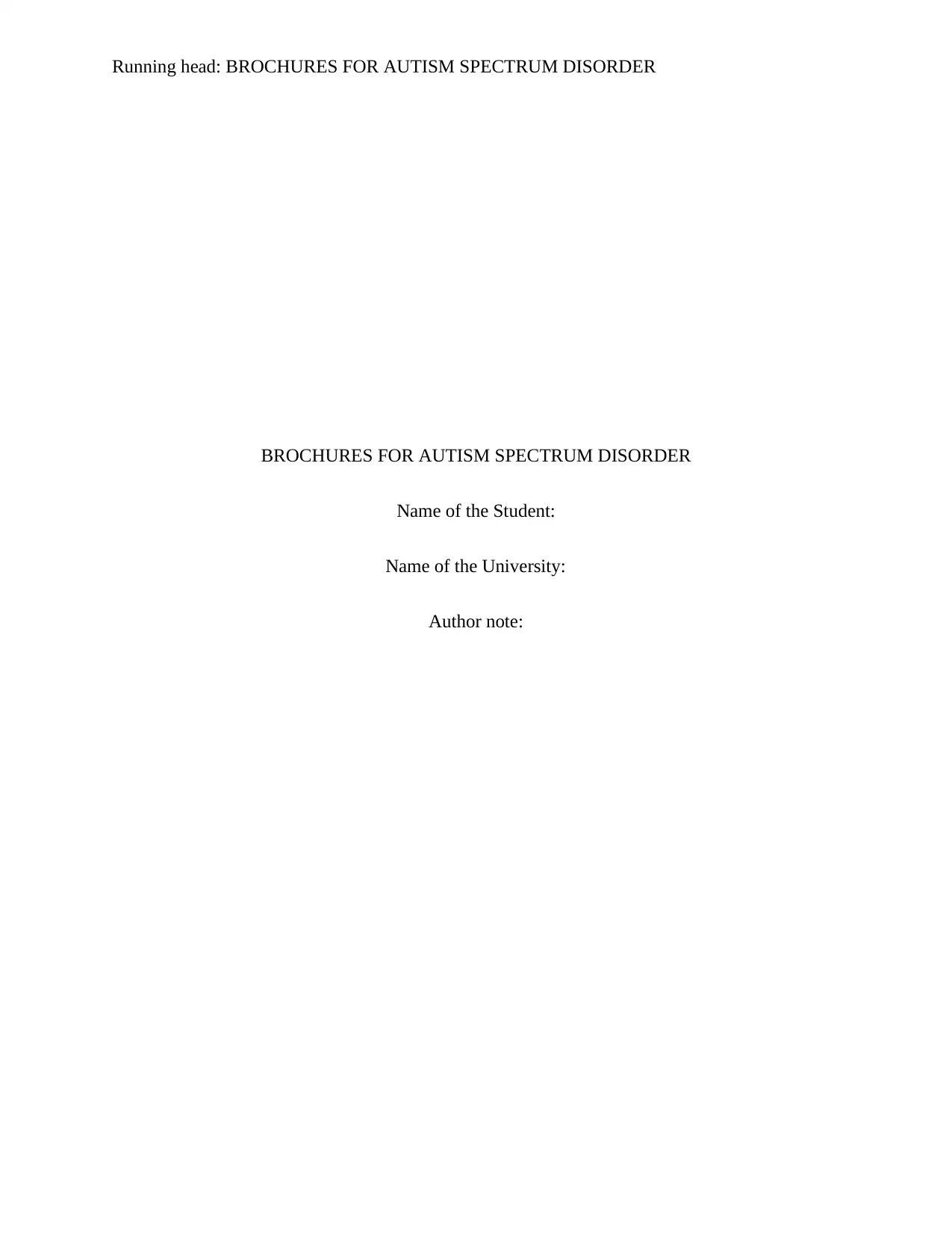
Running head: BROCHURES FOR AUTISM SPECTRUM DISORDER
BROCHURES FOR AUTISM SPECTRUM DISORDER
Name of the Student:
Name of the University:
Author note:
BROCHURES FOR AUTISM SPECTRUM DISORDER
Name of the Student:
Name of the University:
Author note:
Paraphrase This Document
Need a fresh take? Get an instant paraphrase of this document with our AI Paraphraser
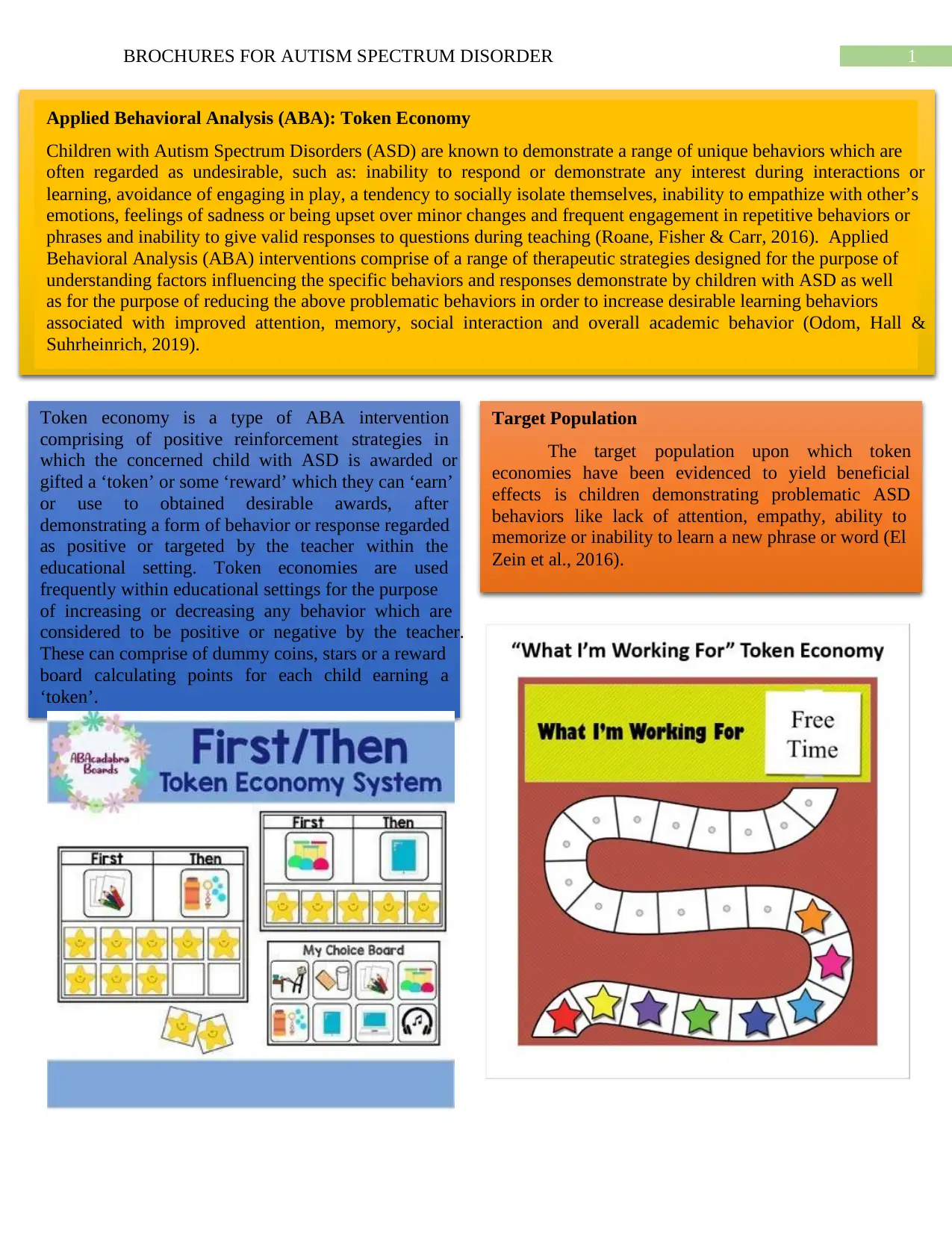
1BROCHURES FOR AUTISM SPECTRUM DISORDER
Applied Behavioral Analysis (ABA): Token Economy
Children with Autism Spectrum Disorders (ASD) are known to demonstrate a range of unique behaviors which are
often regarded as undesirable, such as: inability to respond or demonstrate any interest during interactions or
learning, avoidance of engaging in play, a tendency to socially isolate themselves, inability to empathize with other’s
emotions, feelings of sadness or being upset over minor changes and frequent engagement in repetitive behaviors or
phrases and inability to give valid responses to questions during teaching (Roane, Fisher & Carr, 2016). Applied
Behavioral Analysis (ABA) interventions comprise of a range of therapeutic strategies designed for the purpose of
understanding factors influencing the specific behaviors and responses demonstrate by children with ASD as well
as for the purpose of reducing the above problematic behaviors in order to increase desirable learning behaviors
associated with improved attention, memory, social interaction and overall academic behavior (Odom, Hall &
Suhrheinrich, 2019).
Token economy is a type of ABA intervention
comprising of positive reinforcement strategies in
which the concerned child with ASD is awarded or
gifted a ‘token’ or some ‘reward’ which they can ‘earn’
or use to obtained desirable awards, after
demonstrating a form of behavior or response regarded
as positive or targeted by the teacher within the
educational setting. Token economies are used
frequently within educational settings for the purpose
of increasing or decreasing any behavior which are
considered to be positive or negative by the teacher.
These can comprise of dummy coins, stars or a reward
board calculating points for each child earning a
‘token’.
Target Population
The target population upon which token
economies have been evidenced to yield beneficial
effects is children demonstrating problematic ASD
behaviors like lack of attention, empathy, ability to
memorize or inability to learn a new phrase or word (El
Zein et al., 2016).
Applied Behavioral Analysis (ABA): Token Economy
Children with Autism Spectrum Disorders (ASD) are known to demonstrate a range of unique behaviors which are
often regarded as undesirable, such as: inability to respond or demonstrate any interest during interactions or
learning, avoidance of engaging in play, a tendency to socially isolate themselves, inability to empathize with other’s
emotions, feelings of sadness or being upset over minor changes and frequent engagement in repetitive behaviors or
phrases and inability to give valid responses to questions during teaching (Roane, Fisher & Carr, 2016). Applied
Behavioral Analysis (ABA) interventions comprise of a range of therapeutic strategies designed for the purpose of
understanding factors influencing the specific behaviors and responses demonstrate by children with ASD as well
as for the purpose of reducing the above problematic behaviors in order to increase desirable learning behaviors
associated with improved attention, memory, social interaction and overall academic behavior (Odom, Hall &
Suhrheinrich, 2019).
Token economy is a type of ABA intervention
comprising of positive reinforcement strategies in
which the concerned child with ASD is awarded or
gifted a ‘token’ or some ‘reward’ which they can ‘earn’
or use to obtained desirable awards, after
demonstrating a form of behavior or response regarded
as positive or targeted by the teacher within the
educational setting. Token economies are used
frequently within educational settings for the purpose
of increasing or decreasing any behavior which are
considered to be positive or negative by the teacher.
These can comprise of dummy coins, stars or a reward
board calculating points for each child earning a
‘token’.
Target Population
The target population upon which token
economies have been evidenced to yield beneficial
effects is children demonstrating problematic ASD
behaviors like lack of attention, empathy, ability to
memorize or inability to learn a new phrase or word (El
Zein et al., 2016).
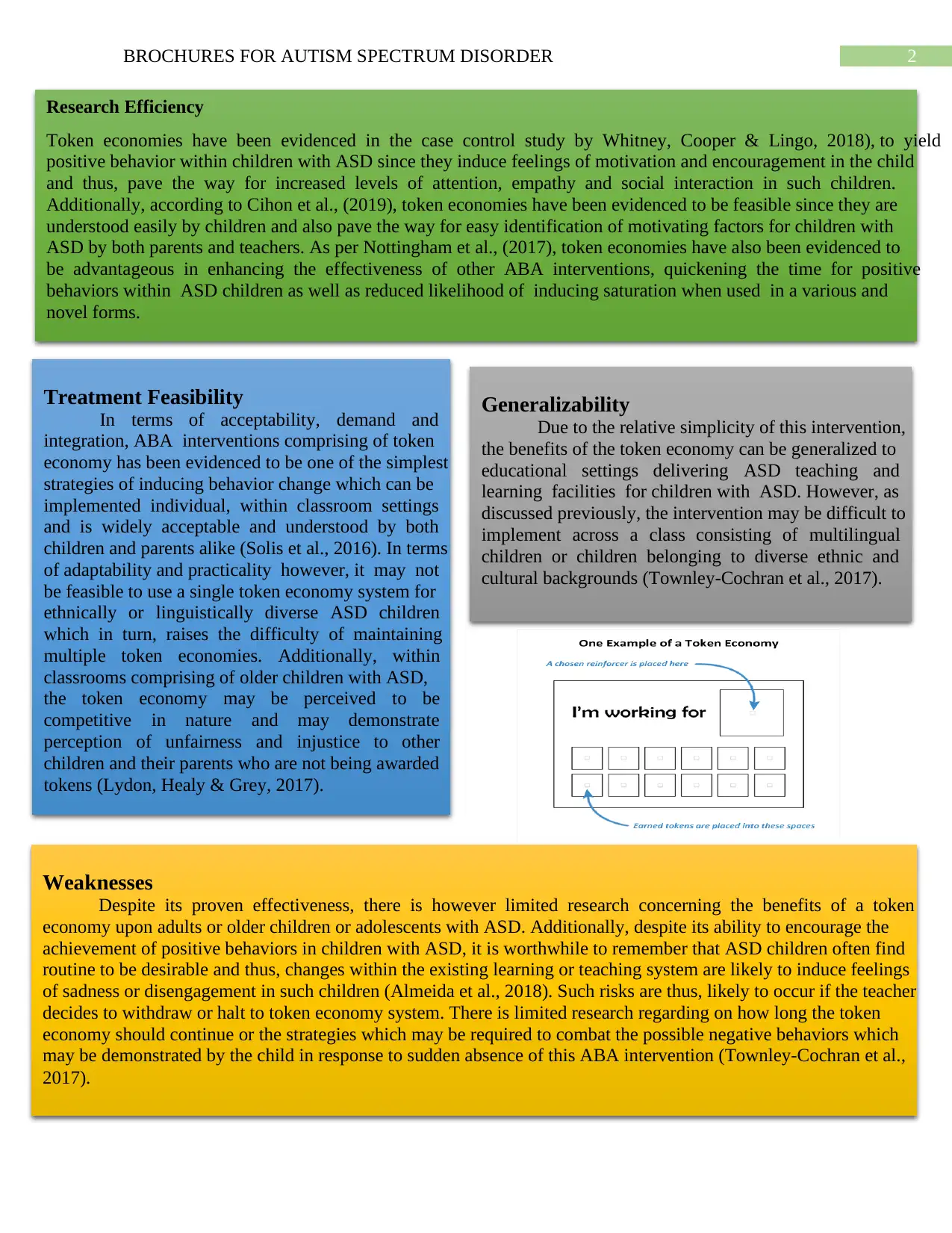
2BROCHURES FOR AUTISM SPECTRUM DISORDER
Research Efficiency
Token economies have been evidenced in the case control study by Whitney, Cooper & Lingo, 2018), to yield
positive behavior within children with ASD since they induce feelings of motivation and encouragement in the child
and thus, pave the way for increased levels of attention, empathy and social interaction in such children.
Additionally, according to Cihon et al., (2019), token economies have been evidenced to be feasible since they are
understood easily by children and also pave the way for easy identification of motivating factors for children with
ASD by both parents and teachers. As per Nottingham et al., (2017), token economies have also been evidenced to
be advantageous in enhancing the effectiveness of other ABA interventions, quickening the time for positive
behaviors within ASD children as well as reduced likelihood of inducing saturation when used in a various and
novel forms.
Treatment Feasibility
In terms of acceptability, demand and
integration, ABA interventions comprising of token
economy has been evidenced to be one of the simplest
strategies of inducing behavior change which can be
implemented individual, within classroom settings
and is widely acceptable and understood by both
children and parents alike (Solis et al., 2016). In terms
of adaptability and practicality however, it may not
be feasible to use a single token economy system for
ethnically or linguistically diverse ASD children
which in turn, raises the difficulty of maintaining
multiple token economies. Additionally, within
classrooms comprising of older children with ASD,
the token economy may be perceived to be
competitive in nature and may demonstrate
perception of unfairness and injustice to other
children and their parents who are not being awarded
tokens (Lydon, Healy & Grey, 2017).
Generalizability
Due to the relative simplicity of this intervention,
the benefits of the token economy can be generalized to
educational settings delivering ASD teaching and
learning facilities for children with ASD. However, as
discussed previously, the intervention may be difficult to
implement across a class consisting of multilingual
children or children belonging to diverse ethnic and
cultural backgrounds (Townley-Cochran et al., 2017).
Weaknesses
Despite its proven effectiveness, there is however limited research concerning the benefits of a token
economy upon adults or older children or adolescents with ASD. Additionally, despite its ability to encourage the
achievement of positive behaviors in children with ASD, it is worthwhile to remember that ASD children often find
routine to be desirable and thus, changes within the existing learning or teaching system are likely to induce feelings
of sadness or disengagement in such children (Almeida et al., 2018). Such risks are thus, likely to occur if the teacher
decides to withdraw or halt to token economy system. There is limited research regarding on how long the token
economy should continue or the strategies which may be required to combat the possible negative behaviors which
may be demonstrated by the child in response to sudden absence of this ABA intervention (Townley-Cochran et al.,
2017).
Research Efficiency
Token economies have been evidenced in the case control study by Whitney, Cooper & Lingo, 2018), to yield
positive behavior within children with ASD since they induce feelings of motivation and encouragement in the child
and thus, pave the way for increased levels of attention, empathy and social interaction in such children.
Additionally, according to Cihon et al., (2019), token economies have been evidenced to be feasible since they are
understood easily by children and also pave the way for easy identification of motivating factors for children with
ASD by both parents and teachers. As per Nottingham et al., (2017), token economies have also been evidenced to
be advantageous in enhancing the effectiveness of other ABA interventions, quickening the time for positive
behaviors within ASD children as well as reduced likelihood of inducing saturation when used in a various and
novel forms.
Treatment Feasibility
In terms of acceptability, demand and
integration, ABA interventions comprising of token
economy has been evidenced to be one of the simplest
strategies of inducing behavior change which can be
implemented individual, within classroom settings
and is widely acceptable and understood by both
children and parents alike (Solis et al., 2016). In terms
of adaptability and practicality however, it may not
be feasible to use a single token economy system for
ethnically or linguistically diverse ASD children
which in turn, raises the difficulty of maintaining
multiple token economies. Additionally, within
classrooms comprising of older children with ASD,
the token economy may be perceived to be
competitive in nature and may demonstrate
perception of unfairness and injustice to other
children and their parents who are not being awarded
tokens (Lydon, Healy & Grey, 2017).
Generalizability
Due to the relative simplicity of this intervention,
the benefits of the token economy can be generalized to
educational settings delivering ASD teaching and
learning facilities for children with ASD. However, as
discussed previously, the intervention may be difficult to
implement across a class consisting of multilingual
children or children belonging to diverse ethnic and
cultural backgrounds (Townley-Cochran et al., 2017).
Weaknesses
Despite its proven effectiveness, there is however limited research concerning the benefits of a token
economy upon adults or older children or adolescents with ASD. Additionally, despite its ability to encourage the
achievement of positive behaviors in children with ASD, it is worthwhile to remember that ASD children often find
routine to be desirable and thus, changes within the existing learning or teaching system are likely to induce feelings
of sadness or disengagement in such children (Almeida et al., 2018). Such risks are thus, likely to occur if the teacher
decides to withdraw or halt to token economy system. There is limited research regarding on how long the token
economy should continue or the strategies which may be required to combat the possible negative behaviors which
may be demonstrated by the child in response to sudden absence of this ABA intervention (Townley-Cochran et al.,
2017).
⊘ This is a preview!⊘
Do you want full access?
Subscribe today to unlock all pages.

Trusted by 1+ million students worldwide
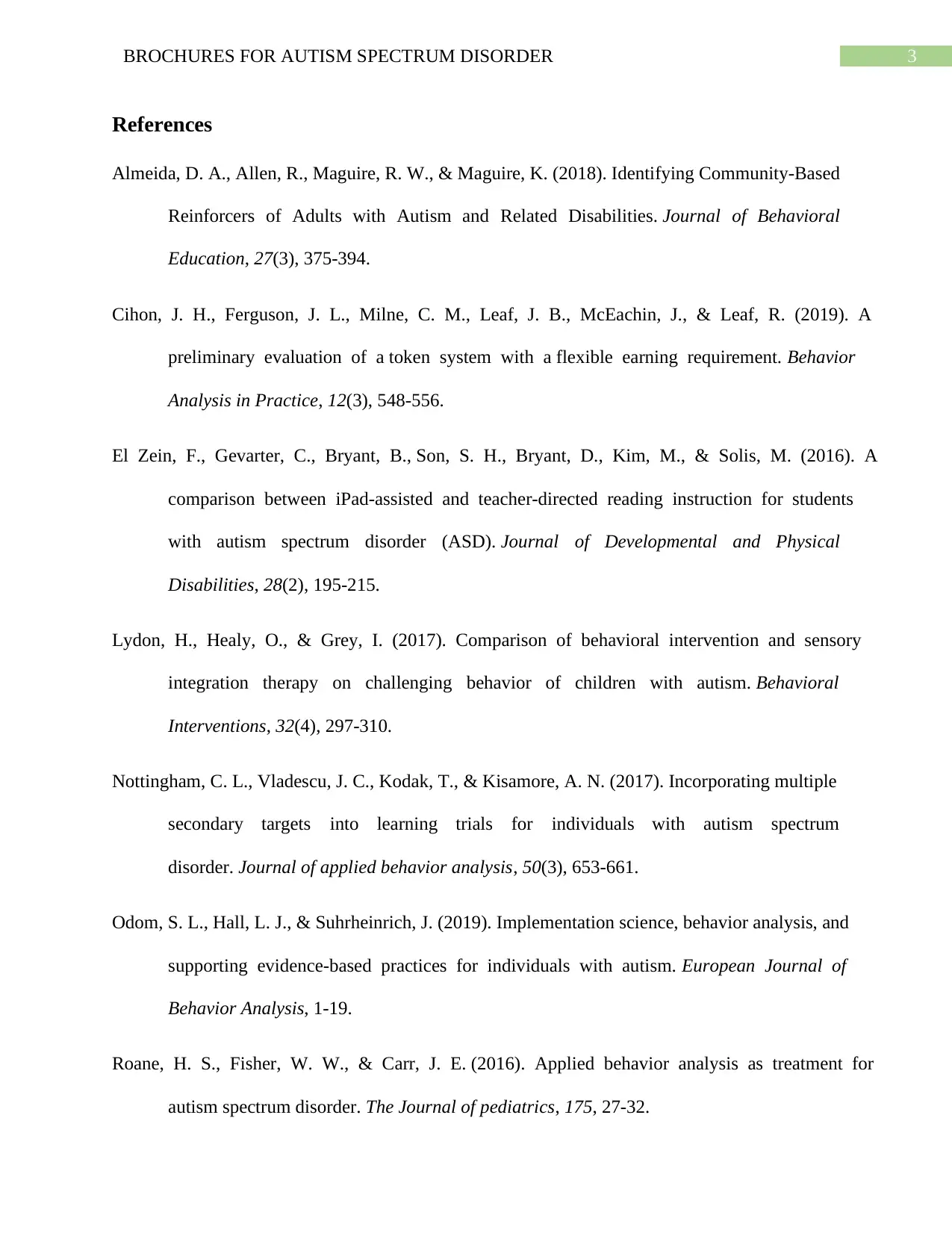
3BROCHURES FOR AUTISM SPECTRUM DISORDER
References
Almeida, D. A., Allen, R., Maguire, R. W., & Maguire, K. (2018). Identifying Community-Based
Reinforcers of Adults with Autism and Related Disabilities. Journal of Behavioral
Education, 27(3), 375-394.
Cihon, J. H., Ferguson, J. L., Milne, C. M., Leaf, J. B., McEachin, J., & Leaf, R. (2019). A
preliminary evaluation of a token system with a flexible earning requirement. Behavior
Analysis in Practice, 12(3), 548-556.
El Zein, F., Gevarter, C., Bryant, B., Son, S. H., Bryant, D., Kim, M., & Solis, M. (2016). A
comparison between iPad-assisted and teacher-directed reading instruction for students
with autism spectrum disorder (ASD). Journal of Developmental and Physical
Disabilities, 28(2), 195-215.
Lydon, H., Healy, O., & Grey, I. (2017). Comparison of behavioral intervention and sensory
integration therapy on challenging behavior of children with autism. Behavioral
Interventions, 32(4), 297-310.
Nottingham, C. L., Vladescu, J. C., Kodak, T., & Kisamore, A. N. (2017). Incorporating multiple
secondary targets into learning trials for individuals with autism spectrum
disorder. Journal of applied behavior analysis, 50(3), 653-661.
Odom, S. L., Hall, L. J., & Suhrheinrich, J. (2019). Implementation science, behavior analysis, and
supporting evidence-based practices for individuals with autism. European Journal of
Behavior Analysis, 1-19.
Roane, H. S., Fisher, W. W., & Carr, J. E. (2016). Applied behavior analysis as treatment for
autism spectrum disorder. The Journal of pediatrics, 175, 27-32.
References
Almeida, D. A., Allen, R., Maguire, R. W., & Maguire, K. (2018). Identifying Community-Based
Reinforcers of Adults with Autism and Related Disabilities. Journal of Behavioral
Education, 27(3), 375-394.
Cihon, J. H., Ferguson, J. L., Milne, C. M., Leaf, J. B., McEachin, J., & Leaf, R. (2019). A
preliminary evaluation of a token system with a flexible earning requirement. Behavior
Analysis in Practice, 12(3), 548-556.
El Zein, F., Gevarter, C., Bryant, B., Son, S. H., Bryant, D., Kim, M., & Solis, M. (2016). A
comparison between iPad-assisted and teacher-directed reading instruction for students
with autism spectrum disorder (ASD). Journal of Developmental and Physical
Disabilities, 28(2), 195-215.
Lydon, H., Healy, O., & Grey, I. (2017). Comparison of behavioral intervention and sensory
integration therapy on challenging behavior of children with autism. Behavioral
Interventions, 32(4), 297-310.
Nottingham, C. L., Vladescu, J. C., Kodak, T., & Kisamore, A. N. (2017). Incorporating multiple
secondary targets into learning trials for individuals with autism spectrum
disorder. Journal of applied behavior analysis, 50(3), 653-661.
Odom, S. L., Hall, L. J., & Suhrheinrich, J. (2019). Implementation science, behavior analysis, and
supporting evidence-based practices for individuals with autism. European Journal of
Behavior Analysis, 1-19.
Roane, H. S., Fisher, W. W., & Carr, J. E. (2016). Applied behavior analysis as treatment for
autism spectrum disorder. The Journal of pediatrics, 175, 27-32.
Paraphrase This Document
Need a fresh take? Get an instant paraphrase of this document with our AI Paraphraser
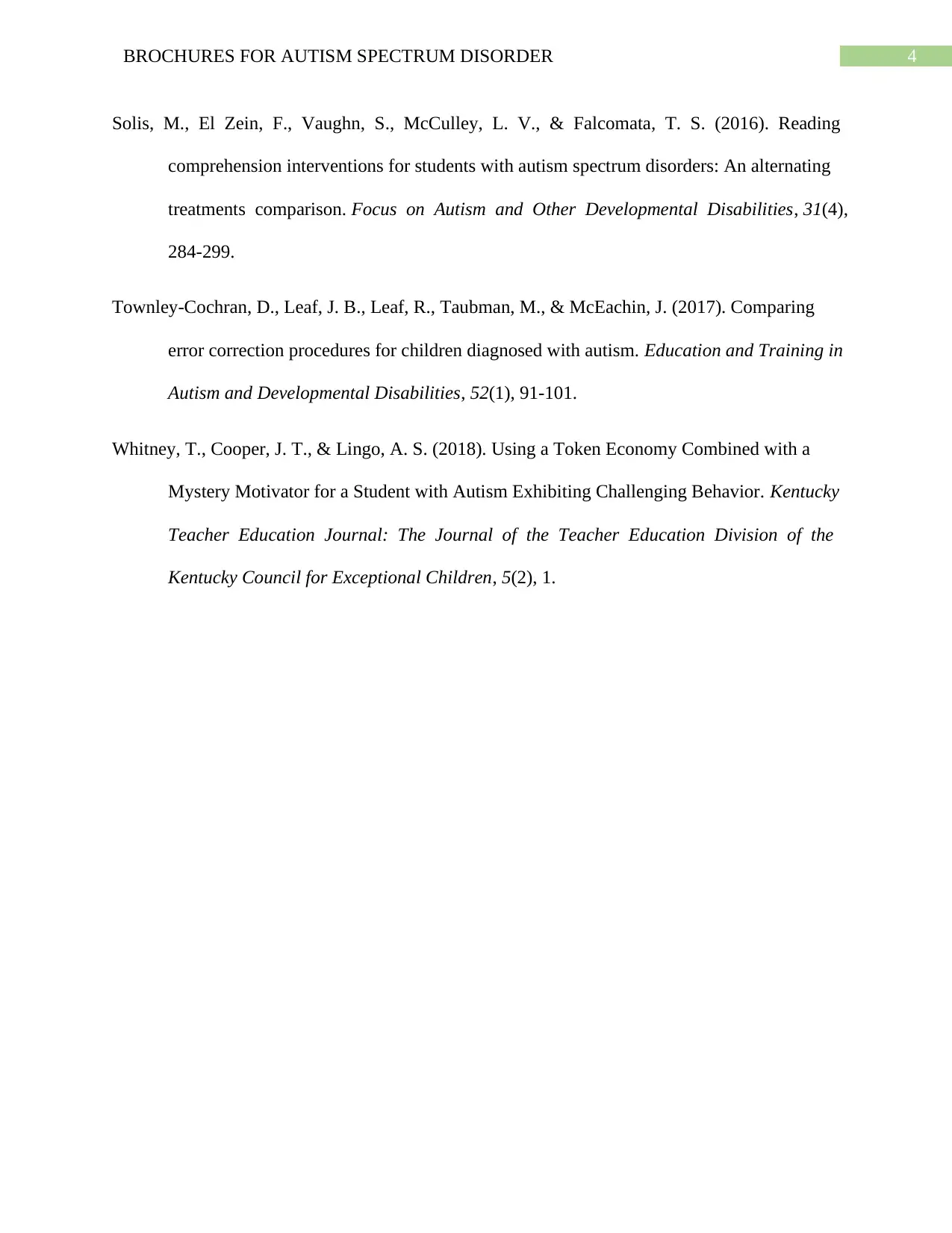
4BROCHURES FOR AUTISM SPECTRUM DISORDER
Solis, M., El Zein, F., Vaughn, S., McCulley, L. V., & Falcomata, T. S. (2016). Reading
comprehension interventions for students with autism spectrum disorders: An alternating
treatments comparison. Focus on Autism and Other Developmental Disabilities, 31(4),
284-299.
Townley-Cochran, D., Leaf, J. B., Leaf, R., Taubman, M., & McEachin, J. (2017). Comparing
error correction procedures for children diagnosed with autism. Education and Training in
Autism and Developmental Disabilities, 52(1), 91-101.
Whitney, T., Cooper, J. T., & Lingo, A. S. (2018). Using a Token Economy Combined with a
Mystery Motivator for a Student with Autism Exhibiting Challenging Behavior. Kentucky
Teacher Education Journal: The Journal of the Teacher Education Division of the
Kentucky Council for Exceptional Children, 5(2), 1.
Solis, M., El Zein, F., Vaughn, S., McCulley, L. V., & Falcomata, T. S. (2016). Reading
comprehension interventions for students with autism spectrum disorders: An alternating
treatments comparison. Focus on Autism and Other Developmental Disabilities, 31(4),
284-299.
Townley-Cochran, D., Leaf, J. B., Leaf, R., Taubman, M., & McEachin, J. (2017). Comparing
error correction procedures for children diagnosed with autism. Education and Training in
Autism and Developmental Disabilities, 52(1), 91-101.
Whitney, T., Cooper, J. T., & Lingo, A. S. (2018). Using a Token Economy Combined with a
Mystery Motivator for a Student with Autism Exhibiting Challenging Behavior. Kentucky
Teacher Education Journal: The Journal of the Teacher Education Division of the
Kentucky Council for Exceptional Children, 5(2), 1.
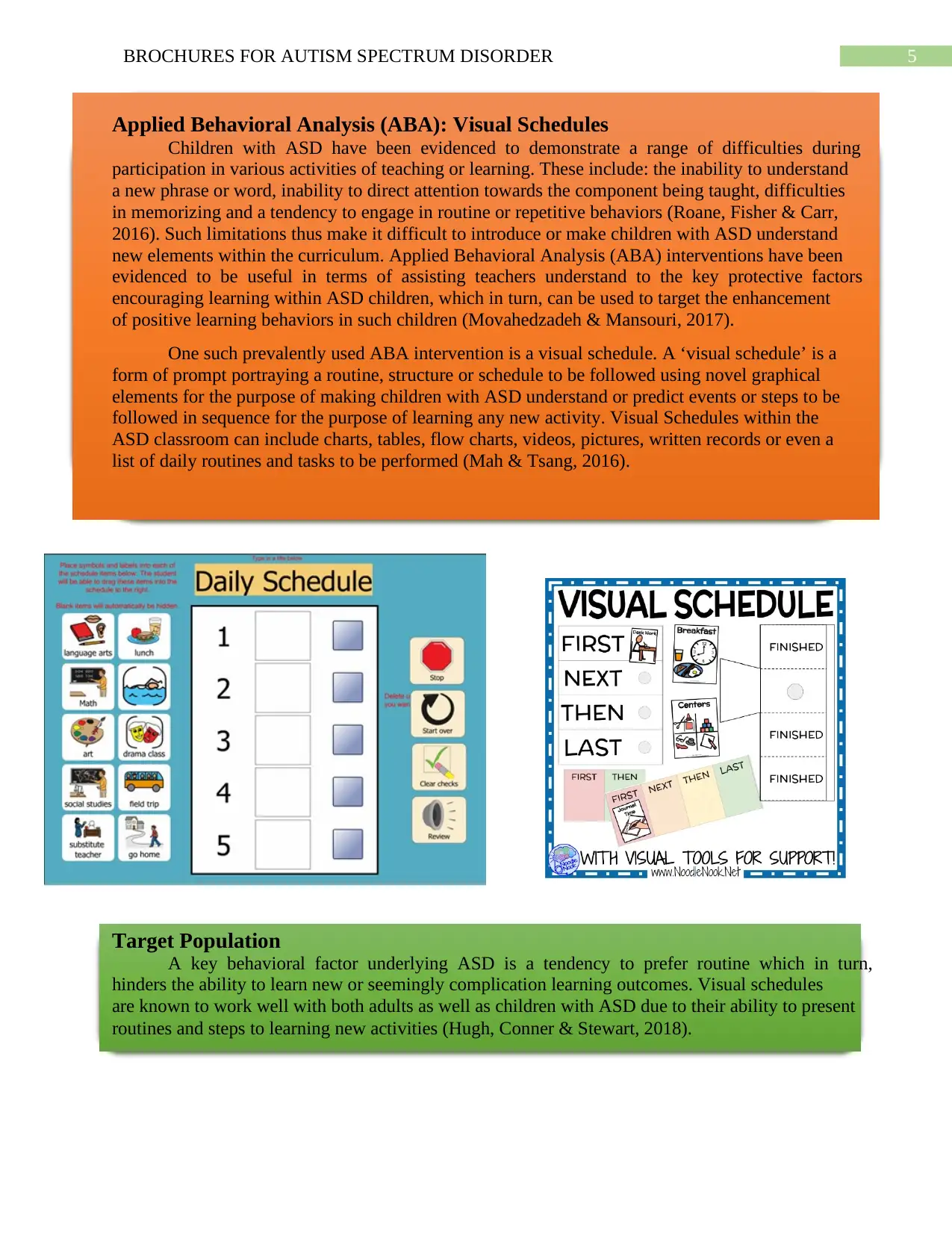
5BROCHURES FOR AUTISM SPECTRUM DISORDER
Applied Behavioral Analysis (ABA): Visual Schedules
Children with ASD have been evidenced to demonstrate a range of difficulties during
participation in various activities of teaching or learning. These include: the inability to understand
a new phrase or word, inability to direct attention towards the component being taught, difficulties
in memorizing and a tendency to engage in routine or repetitive behaviors (Roane, Fisher & Carr,
2016). Such limitations thus make it difficult to introduce or make children with ASD understand
new elements within the curriculum. Applied Behavioral Analysis (ABA) interventions have been
evidenced to be useful in terms of assisting teachers understand to the key protective factors
encouraging learning within ASD children, which in turn, can be used to target the enhancement
of positive learning behaviors in such children (Movahedzadeh & Mansouri, 2017).
One such prevalently used ABA intervention is a visual schedule. A ‘visual schedule’ is a
form of prompt portraying a routine, structure or schedule to be followed using novel graphical
elements for the purpose of making children with ASD understand or predict events or steps to be
followed in sequence for the purpose of learning any new activity. Visual Schedules within the
ASD classroom can include charts, tables, flow charts, videos, pictures, written records or even a
list of daily routines and tasks to be performed (Mah & Tsang, 2016).
Target Population
A key behavioral factor underlying ASD is a tendency to prefer routine which in turn,
hinders the ability to learn new or seemingly complication learning outcomes. Visual schedules
are known to work well with both adults as well as children with ASD due to their ability to present
routines and steps to learning new activities (Hugh, Conner & Stewart, 2018).
Applied Behavioral Analysis (ABA): Visual Schedules
Children with ASD have been evidenced to demonstrate a range of difficulties during
participation in various activities of teaching or learning. These include: the inability to understand
a new phrase or word, inability to direct attention towards the component being taught, difficulties
in memorizing and a tendency to engage in routine or repetitive behaviors (Roane, Fisher & Carr,
2016). Such limitations thus make it difficult to introduce or make children with ASD understand
new elements within the curriculum. Applied Behavioral Analysis (ABA) interventions have been
evidenced to be useful in terms of assisting teachers understand to the key protective factors
encouraging learning within ASD children, which in turn, can be used to target the enhancement
of positive learning behaviors in such children (Movahedzadeh & Mansouri, 2017).
One such prevalently used ABA intervention is a visual schedule. A ‘visual schedule’ is a
form of prompt portraying a routine, structure or schedule to be followed using novel graphical
elements for the purpose of making children with ASD understand or predict events or steps to be
followed in sequence for the purpose of learning any new activity. Visual Schedules within the
ASD classroom can include charts, tables, flow charts, videos, pictures, written records or even a
list of daily routines and tasks to be performed (Mah & Tsang, 2016).
Target Population
A key behavioral factor underlying ASD is a tendency to prefer routine which in turn,
hinders the ability to learn new or seemingly complication learning outcomes. Visual schedules
are known to work well with both adults as well as children with ASD due to their ability to present
routines and steps to learning new activities (Hugh, Conner & Stewart, 2018).
⊘ This is a preview!⊘
Do you want full access?
Subscribe today to unlock all pages.

Trusted by 1+ million students worldwide
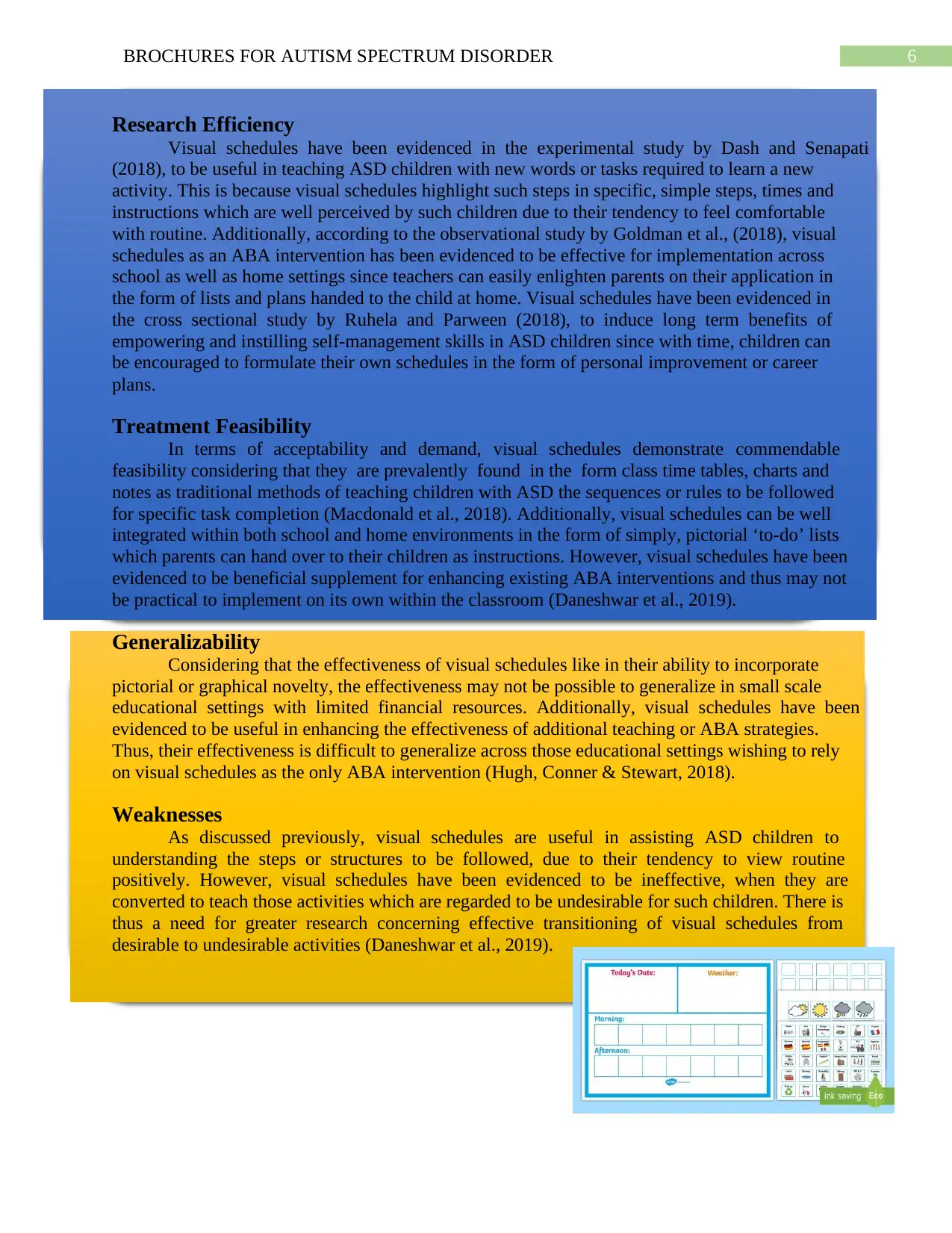
6BROCHURES FOR AUTISM SPECTRUM DISORDER
Research Efficiency
Visual schedules have been evidenced in the experimental study by Dash and Senapati
(2018), to be useful in teaching ASD children with new words or tasks required to learn a new
activity. This is because visual schedules highlight such steps in specific, simple steps, times and
instructions which are well perceived by such children due to their tendency to feel comfortable
with routine. Additionally, according to the observational study by Goldman et al., (2018), visual
schedules as an ABA intervention has been evidenced to be effective for implementation across
school as well as home settings since teachers can easily enlighten parents on their application in
the form of lists and plans handed to the child at home. Visual schedules have been evidenced in
the cross sectional study by Ruhela and Parween (2018), to induce long term benefits of
empowering and instilling self-management skills in ASD children since with time, children can
be encouraged to formulate their own schedules in the form of personal improvement or career
plans.
Treatment Feasibility
In terms of acceptability and demand, visual schedules demonstrate commendable
feasibility considering that they are prevalently found in the form class time tables, charts and
notes as traditional methods of teaching children with ASD the sequences or rules to be followed
for specific task completion (Macdonald et al., 2018). Additionally, visual schedules can be well
integrated within both school and home environments in the form of simply, pictorial ‘to-do’ lists
which parents can hand over to their children as instructions. However, visual schedules have been
evidenced to be beneficial supplement for enhancing existing ABA interventions and thus may not
be practical to implement on its own within the classroom (Daneshwar et al., 2019).
Generalizability
Considering that the effectiveness of visual schedules like in their ability to incorporate
pictorial or graphical novelty, the effectiveness may not be possible to generalize in small scale
educational settings with limited financial resources. Additionally, visual schedules have been
evidenced to be useful in enhancing the effectiveness of additional teaching or ABA strategies.
Thus, their effectiveness is difficult to generalize across those educational settings wishing to rely
on visual schedules as the only ABA intervention (Hugh, Conner & Stewart, 2018).
Weaknesses
As discussed previously, visual schedules are useful in assisting ASD children to
understanding the steps or structures to be followed, due to their tendency to view routine
positively. However, visual schedules have been evidenced to be ineffective, when they are
converted to teach those activities which are regarded to be undesirable for such children. There is
thus a need for greater research concerning effective transitioning of visual schedules from
desirable to undesirable activities (Daneshwar et al., 2019).
Research Efficiency
Visual schedules have been evidenced in the experimental study by Dash and Senapati
(2018), to be useful in teaching ASD children with new words or tasks required to learn a new
activity. This is because visual schedules highlight such steps in specific, simple steps, times and
instructions which are well perceived by such children due to their tendency to feel comfortable
with routine. Additionally, according to the observational study by Goldman et al., (2018), visual
schedules as an ABA intervention has been evidenced to be effective for implementation across
school as well as home settings since teachers can easily enlighten parents on their application in
the form of lists and plans handed to the child at home. Visual schedules have been evidenced in
the cross sectional study by Ruhela and Parween (2018), to induce long term benefits of
empowering and instilling self-management skills in ASD children since with time, children can
be encouraged to formulate their own schedules in the form of personal improvement or career
plans.
Treatment Feasibility
In terms of acceptability and demand, visual schedules demonstrate commendable
feasibility considering that they are prevalently found in the form class time tables, charts and
notes as traditional methods of teaching children with ASD the sequences or rules to be followed
for specific task completion (Macdonald et al., 2018). Additionally, visual schedules can be well
integrated within both school and home environments in the form of simply, pictorial ‘to-do’ lists
which parents can hand over to their children as instructions. However, visual schedules have been
evidenced to be beneficial supplement for enhancing existing ABA interventions and thus may not
be practical to implement on its own within the classroom (Daneshwar et al., 2019).
Generalizability
Considering that the effectiveness of visual schedules like in their ability to incorporate
pictorial or graphical novelty, the effectiveness may not be possible to generalize in small scale
educational settings with limited financial resources. Additionally, visual schedules have been
evidenced to be useful in enhancing the effectiveness of additional teaching or ABA strategies.
Thus, their effectiveness is difficult to generalize across those educational settings wishing to rely
on visual schedules as the only ABA intervention (Hugh, Conner & Stewart, 2018).
Weaknesses
As discussed previously, visual schedules are useful in assisting ASD children to
understanding the steps or structures to be followed, due to their tendency to view routine
positively. However, visual schedules have been evidenced to be ineffective, when they are
converted to teach those activities which are regarded to be undesirable for such children. There is
thus a need for greater research concerning effective transitioning of visual schedules from
desirable to undesirable activities (Daneshwar et al., 2019).
Paraphrase This Document
Need a fresh take? Get an instant paraphrase of this document with our AI Paraphraser
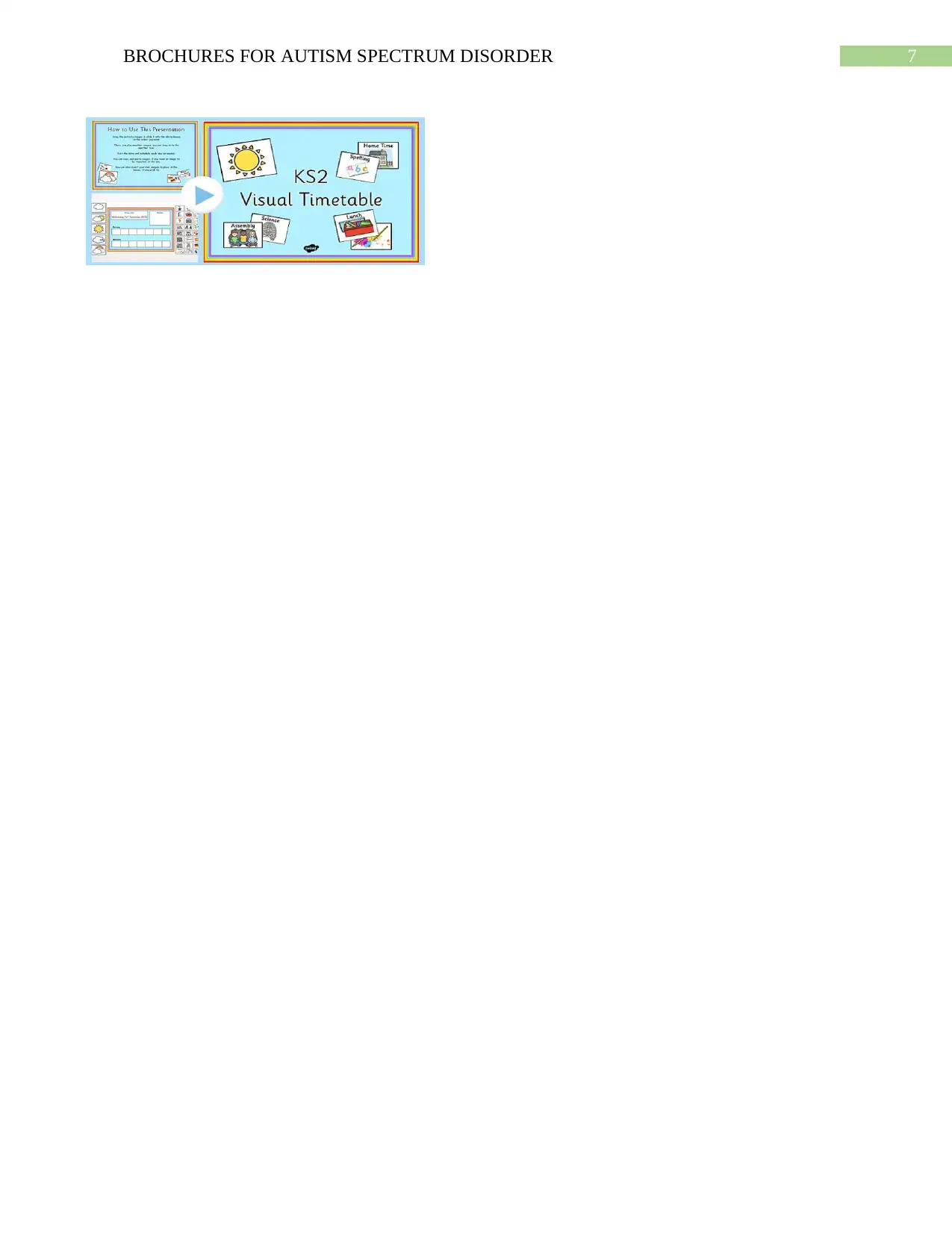
7BROCHURES FOR AUTISM SPECTRUM DISORDER
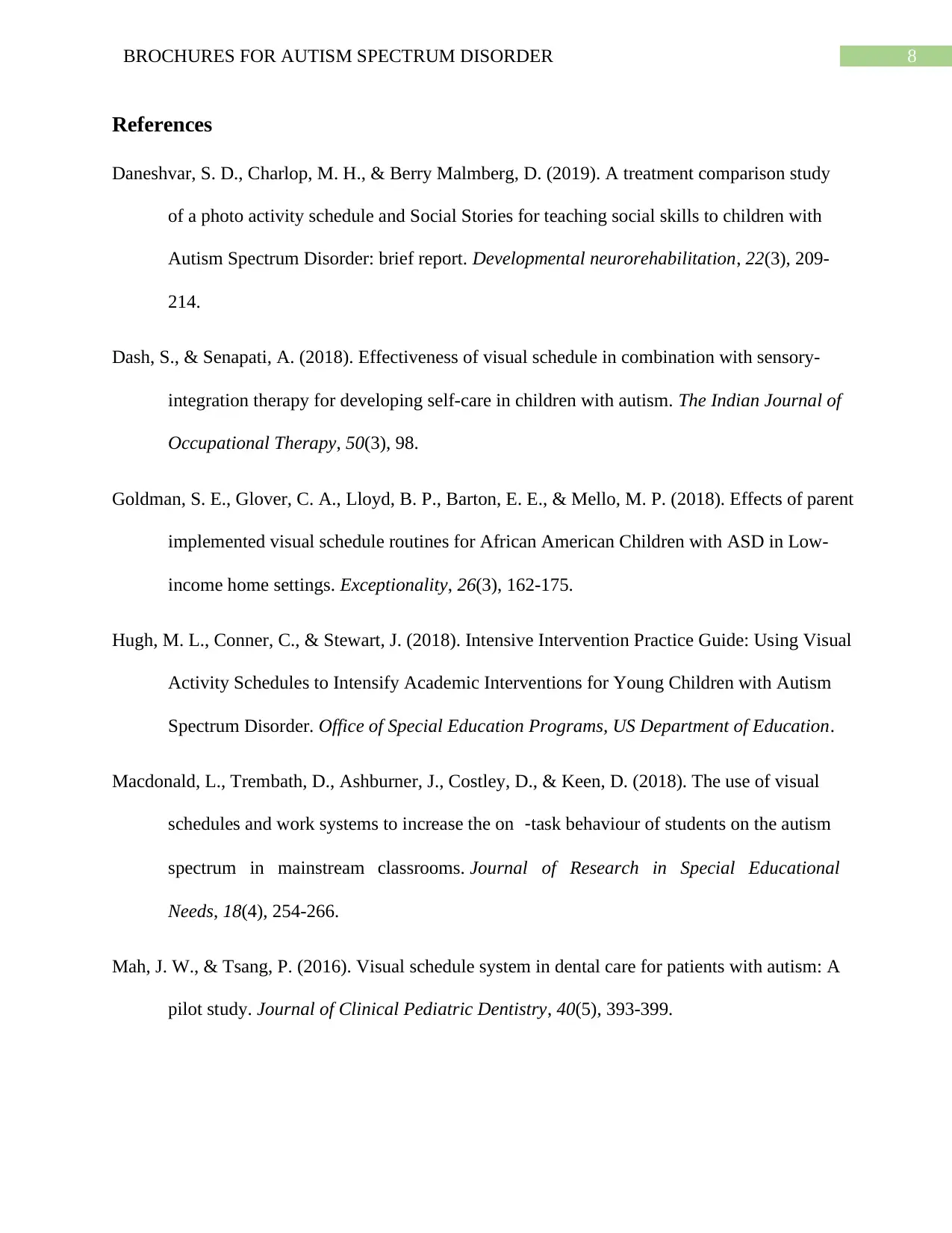
8BROCHURES FOR AUTISM SPECTRUM DISORDER
References
Daneshvar, S. D., Charlop, M. H., & Berry Malmberg, D. (2019). A treatment comparison study
of a photo activity schedule and Social Stories for teaching social skills to children with
Autism Spectrum Disorder: brief report. Developmental neurorehabilitation, 22(3), 209-
214.
Dash, S., & Senapati, A. (2018). Effectiveness of visual schedule in combination with sensory-
integration therapy for developing self-care in children with autism. The Indian Journal of
Occupational Therapy, 50(3), 98.
Goldman, S. E., Glover, C. A., Lloyd, B. P., Barton, E. E., & Mello, M. P. (2018). Effects of parent
implemented visual schedule routines for African American Children with ASD in Low-
income home settings. Exceptionality, 26(3), 162-175.
Hugh, M. L., Conner, C., & Stewart, J. (2018). Intensive Intervention Practice Guide: Using Visual
Activity Schedules to Intensify Academic Interventions for Young Children with Autism
Spectrum Disorder. Office of Special Education Programs, US Department of Education.
Macdonald, L., Trembath, D., Ashburner, J., Costley, D., & Keen, D. (2018). The use of visual
schedules and work systems to increase the on ‐task behaviour of students on the autism
spectrum in mainstream classrooms. Journal of Research in Special Educational
Needs, 18(4), 254-266.
Mah, J. W., & Tsang, P. (2016). Visual schedule system in dental care for patients with autism: A
pilot study. Journal of Clinical Pediatric Dentistry, 40(5), 393-399.
References
Daneshvar, S. D., Charlop, M. H., & Berry Malmberg, D. (2019). A treatment comparison study
of a photo activity schedule and Social Stories for teaching social skills to children with
Autism Spectrum Disorder: brief report. Developmental neurorehabilitation, 22(3), 209-
214.
Dash, S., & Senapati, A. (2018). Effectiveness of visual schedule in combination with sensory-
integration therapy for developing self-care in children with autism. The Indian Journal of
Occupational Therapy, 50(3), 98.
Goldman, S. E., Glover, C. A., Lloyd, B. P., Barton, E. E., & Mello, M. P. (2018). Effects of parent
implemented visual schedule routines for African American Children with ASD in Low-
income home settings. Exceptionality, 26(3), 162-175.
Hugh, M. L., Conner, C., & Stewart, J. (2018). Intensive Intervention Practice Guide: Using Visual
Activity Schedules to Intensify Academic Interventions for Young Children with Autism
Spectrum Disorder. Office of Special Education Programs, US Department of Education.
Macdonald, L., Trembath, D., Ashburner, J., Costley, D., & Keen, D. (2018). The use of visual
schedules and work systems to increase the on ‐task behaviour of students on the autism
spectrum in mainstream classrooms. Journal of Research in Special Educational
Needs, 18(4), 254-266.
Mah, J. W., & Tsang, P. (2016). Visual schedule system in dental care for patients with autism: A
pilot study. Journal of Clinical Pediatric Dentistry, 40(5), 393-399.
⊘ This is a preview!⊘
Do you want full access?
Subscribe today to unlock all pages.

Trusted by 1+ million students worldwide
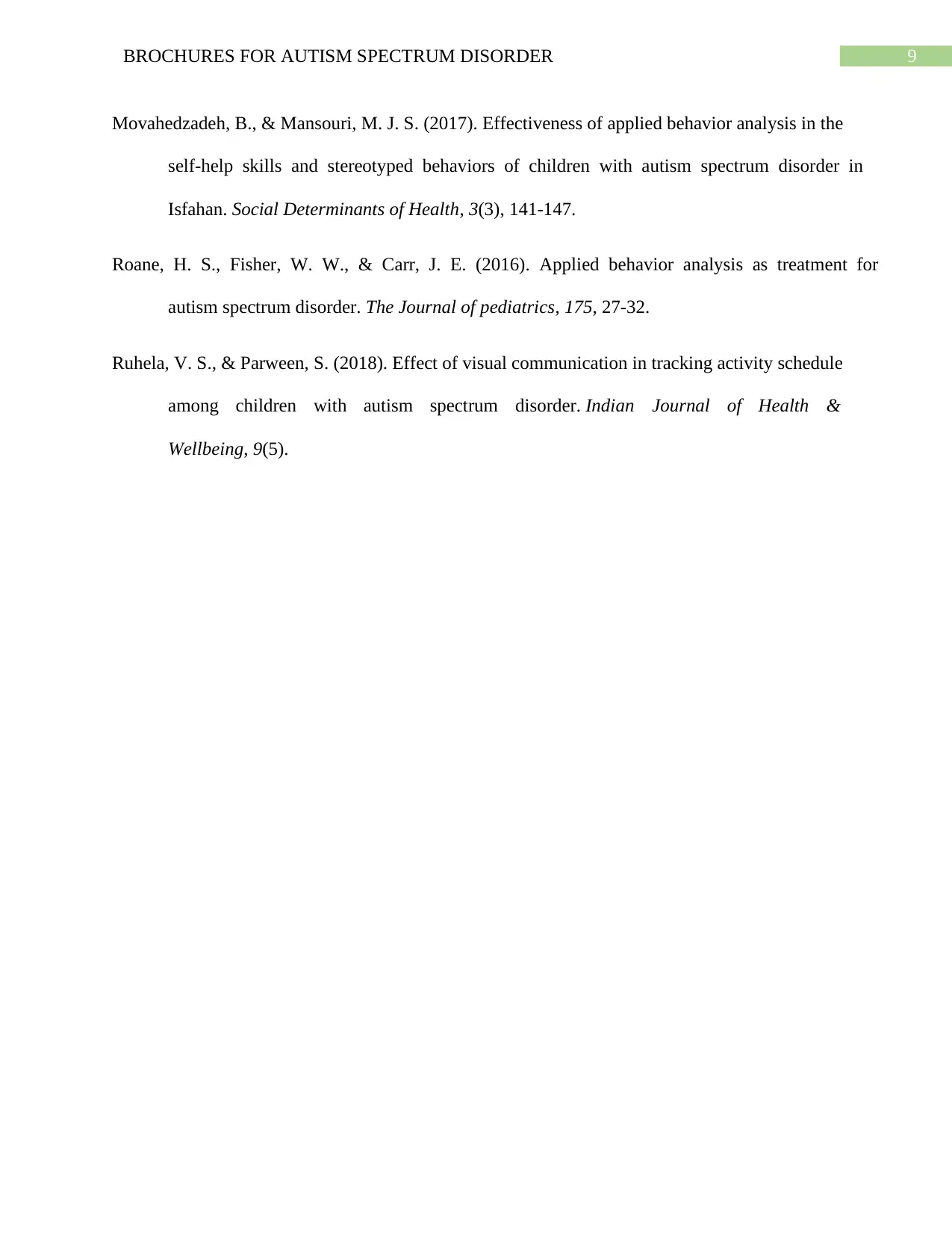
9BROCHURES FOR AUTISM SPECTRUM DISORDER
Movahedzadeh, B., & Mansouri, M. J. S. (2017). Effectiveness of applied behavior analysis in the
self-help skills and stereotyped behaviors of children with autism spectrum disorder in
Isfahan. Social Determinants of Health, 3(3), 141-147.
Roane, H. S., Fisher, W. W., & Carr, J. E. (2016). Applied behavior analysis as treatment for
autism spectrum disorder. The Journal of pediatrics, 175, 27-32.
Ruhela, V. S., & Parween, S. (2018). Effect of visual communication in tracking activity schedule
among children with autism spectrum disorder. Indian Journal of Health &
Wellbeing, 9(5).
Movahedzadeh, B., & Mansouri, M. J. S. (2017). Effectiveness of applied behavior analysis in the
self-help skills and stereotyped behaviors of children with autism spectrum disorder in
Isfahan. Social Determinants of Health, 3(3), 141-147.
Roane, H. S., Fisher, W. W., & Carr, J. E. (2016). Applied behavior analysis as treatment for
autism spectrum disorder. The Journal of pediatrics, 175, 27-32.
Ruhela, V. S., & Parween, S. (2018). Effect of visual communication in tracking activity schedule
among children with autism spectrum disorder. Indian Journal of Health &
Wellbeing, 9(5).
1 out of 10
Your All-in-One AI-Powered Toolkit for Academic Success.
+13062052269
info@desklib.com
Available 24*7 on WhatsApp / Email
![[object Object]](/_next/static/media/star-bottom.7253800d.svg)
Unlock your academic potential
Copyright © 2020–2025 A2Z Services. All Rights Reserved. Developed and managed by ZUCOL.


